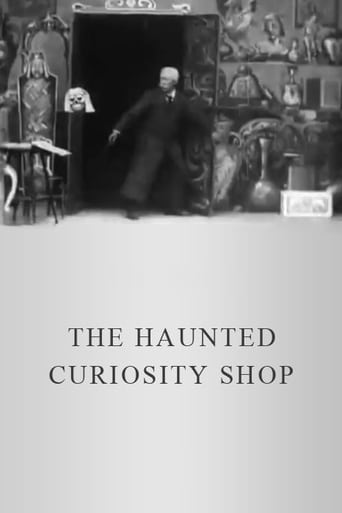MartinHafer
In the very early days of film, outright stealing of ideas was rampant. Often, when a good idea developed, other filmmakers would copy it EXACTLY or as exactly as possible and market the product as their own. It clearly was theft and nowadays you'd get sued for such blatant ripoffs. But in the 1895-1910 era, the problem abounded. For example, I've seen an alternate version of the groundbreaking "Voyage Dan Le Lune" (Georges Méliès) that was so close to the original that I thought perhaps Méliès had decided to rework or remake his own film.In the case of "The Old Curiosity Shop", Walter Booth decided to make a film that wasn't exactly a copy of Méliès' work--but was very strongly inspired by it. It features a scene that is very, very similar--with a man making things appear and disappear through the use of double-exposures and stop-motion. But, unlike a Méliès film, the tricks come VERY rapid-fire--so quickly that the film lacks grace--though the tricks, by 1901 standards, are quite nice.One other note. The plot of this knockoff film is not exactly as it is described in the IMDb summary. Perhaps there are various versions of this film varying in lengths. The one I downloaded from archive.org (which are often linked to IMDb--but this film is not) had cute gnomes and no hint of the old lady wanting a kiss from the conjurer.
JoeytheBrit
Robert Paul is a largely forgotten name today, but he was a major pioneer of British cinema, and was quick to grasp the commercial potential of cinema in ways that better known pioneers such as William Friese-Greene were not. He was more of a mechanic than a filmmaker making, with Birt Acres, his own camera on which to shoot films in 1895, and also Britain's first projector, the Animatograph, with which to screen them in 1896. Early in the 20th century he had a custom-made studio built in Muswell Hill.The Haunted Curiosity Shop is a special-effects film made for Robert Paul by Walter Booth. There's no real story to speak of, and the film really just serves as a showcase for Booth's technical wizardry. Its use of stop-motion, substitution and matte photography is quite sophisticated and fast-moving for its day.
F Gwynplaine MacIntyre
I viewed the British Film Institute print of this early 'trick' film. This brief and enjoyable comedy is purely a vehicle for some conjuring tricks, all of which are achieved in the camera rather than through stagecraft. The tricks are well done, with the jump cuts and other fakery being rather more difficult to spot here than in many other 'trick' films of this same era.The Edison Company's synopsis, included on IMDb's web page for this film, is accurate enough. I was intrigued by the business featuring a beautiful woman divided into upper and lower halves. This impressed me for two different reasons. Firstly, the earliest example (to my knowledge) of a stage conjuror sawing a woman in half was P.T. Selbit, about 20 years AFTER this movie was made: is it possible that the well-known stage illusion was actually inspired by this movie?Secondly, I was intrigued that this movie was imaginative enough to introduce the top half of the woman without the bottom half, and then show her bottom half walking into the scene. This is much more clever (and unexpected) than the more obvious lurk of showing a normal woman, then making her divide into halves. Compare this with the awful scene in 'Follow the Boys' when Orson Welles supposedly saws Marlene Dietrich in half, in front of a live audience of servicemen. Marlene's lower half gets up and walks away, while the soldiers hoot with delight ... but this is blatantly a camera trick, so we know that the 'audience' aren't seeing what we're seeing, and we know they're giving a scripted reaction.The magic tricks in 'The Haunted Curiosity Shop' are actually more convincing than the make-up job on the actor playing the antiques dealer. My rating: 9 out of 10.
SlothNOIR
This short film is a succession of appearing, disappearing, split second metamorphoses and character fades. There is no obvious story line. The Curiosity Shop contains mainly Egyptian artifacts. It seems to be well executed for its time.
